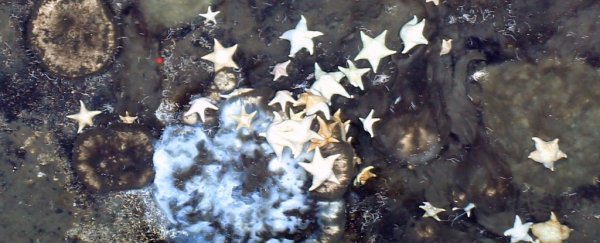The bottom of the Arctic Ocean, below the permanent sea ice, is not a friendly place for life.
Down there in the cold dark, nutrients and vegetation are sparse; it's expected that any life that does manage to eke out an existence under these conditions would be likewise thin on the ground.
Scientists were very surprised to discover, therefore, a thriving and dense population of sponges occupying inactive volcanic seamounts at mesopelagic depths in the Central Arctic Ocean.
"Thriving on top of extinct volcanic seamounts of the Langseth Ridge we found massive sponge gardens, but did not know what they were feeding on," says marine biologist Antje Boetius of the Helmholtz Center for Polar and Marine Research's Alfred Wegener Institute in Germany.
Sponge gardens, as such communities are known, are very important for marine ecosystems. They provide habitat niches for other organisms, as well as contribute to nutrient cycling in the waters they inhabit. As filter feeders, they have a diverse diet, with communities adept at exploiting whatever is available in their own habitat.
At Langseth Ridge, however, there doesn't seem to be much to exploit. Obviously some sleuthing was in order. A team of researchers set about conducting under-ice seafloor mapping and biomass sampling, to both identify the sponge species and figure out what they were eating.
The answer was another surprise.
"Our analysis revealed that the sponges have microbial symbionts that are able to use old organic matter," explains Teresa Morganti of the Max Planck Institute for Marine Microbiology in Germany.
"This allows them to feed on the remnants of former, now extinct inhabitants of the seamounts, such as the tubes of worms composed of protein and chitin and other trapped detritus."
Sponges are very simple yet successful life forms. They have no muscles, no nerves, no organs. They do, however, have one trait that helps them adapt to and survive in such a wide range of environments: just like us they rely on the help of their microbiomes, but to an even greater extent.
In their porous bodies, they host diverse communities of microbes, such as bacteria, microalgae and archaea. Up to 40 percent of a sponge's volume can be symbiont microbes.
These microbes can contribute to their host's metabolism quite significantly, through such mechanisms as photosynthesis and nitrogen fixation, the disposal of excretion or the production of antibiotics, that the host wouldn't be able to do on their own. This turned out to be the case with the arctic sponges, too.
The majority of the sponges in the Langseth Ridge garden are what are known as bacteriosponges, where a significant percentage of the microbial population consists of bacteria.
Most of them belong to the genus Geodia, with an average age of about 300 years (not unusual for sponges). And it turned out that the bacteria that inhabit these sponges are the key to their strange diet.
Once upon a time, thousands of years ago, those volcanic seamounts were active. Such hydrothermal regions facilitate thriving ecosystems, even in dark, frigid waters.
The infusion of volcanic chemicals into the water, as well as the warmth, support food webs based on chemosynthesis – harnessing chemical reactions for energy, rather than the sunlight used in photosynthesis.
When the seamounts died and cooled, so too did the ecosystems that relied on them, leaving behind their remains. Very little in the ocean, however, goes to waste, even the remains of extinct organisms. Where there's a resource, a niche will often emerge.
"The microbes have just the right toolbox for this habitat," says marine microbiologist Ute Hentschel of the GEOMAR Helmholtz Centre for Ocean Research in Germany.
"The microbes have the genes to digest refractory particulate and dissolved organic matter and use it as a carbon and nitrogen source, as well as a number of chemical energy sources available there."
It's a marvelous and peculiar ecosystem, demonstrating yet another way life can carve out a place for itself even in the most difficult places to do so.
"This is a unique ecosystem. We have never seen anything like it before in the high Central Arctic," Boetius says.
"In the study area, primary productivity in the overlying water provides less than one percent of the sponges' carbon demand. Thus, this sponge garden may be a transient ecosystem, but it is rich in species, including soft corals."
But, the researchers noted, the discovery also highlights how much biodiversity may be unknown to us in habitats inhospitable to humans.
In places like the Arctic, under the horrifying threat of climate change, understanding the biodiversity will be essential for trying to protect it, the team says.
The research has been published in Nature Communications.
